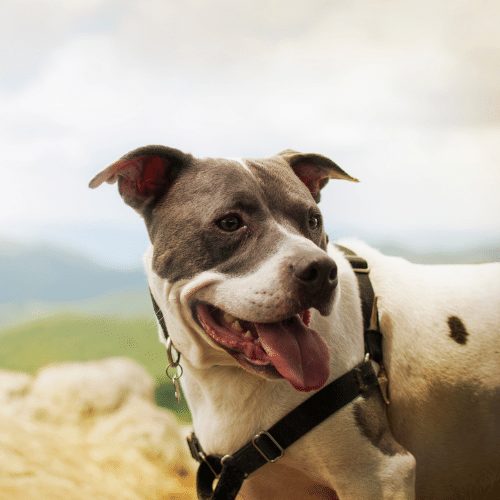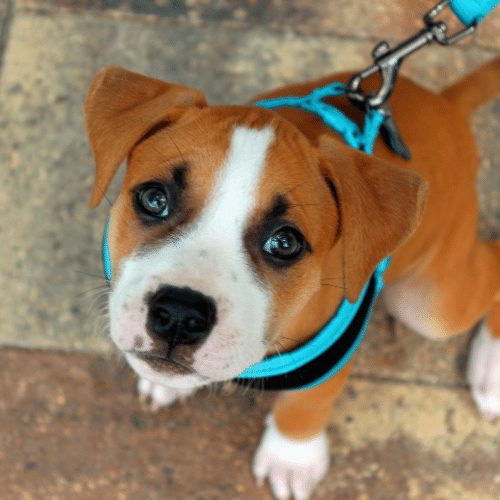Harnesses
May 30, 2021 2021-06-25 10:28Harnesses
Harnesses come in a variety of shapes, colors and styles. They can be used either as an addition to collars or as a standalone piece of gear that your dog is wearing.
Harnesses were originally used mostly in the sled dog world, but they have become increasingly popular in recent years. They are gentle on the dog’s body, prevent damage on the neck from a dog suddenly crashing into his collar and distribute the pull of the leash evenly over the dog’s chest and shoulders.
Let’s look at the most common questions about harnesses and then dive into some harness reviews!

Table of contents
Are harnesses good for dogs?
Yes! Harnesses are great for dogs. They are a safe and comfortable way to walk a dog of any age, size and breed. Every dog owner should get a harness for their dog in addition to a collar, even if the dog can already walk very well on leash. It is one of the tools I recommend for all my clients, no matter how old or trained their dog already is.
Every puppy owner should walk their dog on a harness. Puppies have not yet learned how to properly walk on a leash and are likely to dash left and right, suddenly stop to sniff something along the way or take off racing when they see something interesting. A puppy should never crash into his collar like this – it could lead to lasting neck and throat damage.
By having your puppy wear a harness, you can let him explore the world to his heart’s content on walks without having to worry about him hurting his neck in a collar.
Harnesses also allow dog owners to work with their reactive dogs and to let their dogs sniff on a loose, long line. Whenever we are training with nervous, anxious, stressed and high-strung dogs, removing pressure on the throat is an important first step. We should never train with an already amped up dog on a collar – the pressure will only add to the dog’s excitement and wildness.
Why are harnesses bad for dogs?
Some dog trainers still claim that all harnesses are bad for dogs. This is not the case. There are however some key points you want to keep in mind when choosing the right harness.
The following harnesses can be bad for dogs:
No-Pull harnesses can be bad for dogs
No-pull harnesses are designed to discourage the dog from pulling through tightening a strap across the dog’s chest. This can actually alter his gait and make him walk with a shortened stride. The dog tries to avoid hitting the o-ring and carabiner that is dangling right in front of his legs, and the tight strap across the chest does not allow his shoulders and front legs to move as they normally would.

Having a dog wear such a harness for a week or two will not lead to any lasting damage. Walking your dog exclusively on this harness over months and years however could result in musculoskeletal changes through continued decreased range of motion in their shoulders.
In addition to these issues, no-pull harnesses actually are not that effective in reducing pulling in dogs that already have very bad leash pulling habits – they tend to just ignore the harness and continue pulling as they always have.
It will be much better to teach your dog to not pull on leash through targeted training.
Non-padded harnesses can be bad for short coated dogs
If you have a dog with a very short coat such as a Pitbull or Doberman, having a harness with bare nylon straps could lead to chafing. For dogs with thin fur you always want to make sure that the straps behind the dog’s front legs are soft and padded.
All dogs – regardless of breed – tend to have slightly thinner hair behind their front legs (in their doggy armpit, so to speak). For dogs with a long and lush coat this will not make a difference in choosing a harness, but for short-coated dogs the wrong harness can easily lead to raw spots. Regularly check the fit of your dog’s harness and make sure it is comfortable for your dog, especially if you are planning on having him wear it for longer walks or hikes.
Do dogs pull more with a harness?
Dogs do not pull more in a harness. Whether or not a dog pulls depends on how much training in leash walking he has had, and how much of a history he has for pulling badly.
Dogs typically pull on leash because they have experienced that this lets them move on a walk. They start pulling just a little bit as a puppy, and then gradually increase the amount of force with which they pull forward. Owners initially do not react to the pulling (because being “dragged” by a 10 lbs puppy is not so bad at all) and by the time they realize that their dog is pulling too much, the behavior is already really ingrained.
These poor leash manners however do not depend on whether the dog wears a collar or a harness – it depends on whether the owner has taught the dog to stay by their side and keep a loose leash or not!
A dog that has been taught how to walk well on a leash will do well without pulling on a harness. A dog that has not been taught to walk well however will also pull on a collar. The tool does not teach the behavior!
When should you put a dog’s harness on?
Ideally you should put on the harness every time you are planning to take your dog on a walk or an outing. The more often your dog wears his harness, the faster he gets used to it and the more use you will get out of it.

Some dogs are initially scared by having the harness put on. If this is the case with your dog, you can pair the harness with many treats in order to make it more enticing for your dog. Don’t chase your dog through the house with his harness, this will only make him more apprehensive.
Instead, make putting on the harness an exciting and special event: Get some really delicious goodies (such as freeze-dried liver or small pieces of hotdogs) and feed them to your dog as and after you put on the harness.
Can I leave my dog’s harness on all day?
Unless you are on a long hike or an overnight camping trip, there is no reason to leave your dog’s harness on all day. Harnesses are meant to be worn out and about, but not at home. Especially for dogs with a short coat, wearing a harness 24/7 can lead to chafing and raw spots (mostly behind their front legs).
Don’t leave a harness on your dog all day unless there is a reason to do so. A harness is a functional piece of equipment, not an accessory to be worn for long hours.
Do dogs need a collar and a harness?

Yes, you should get both a collar and a harness for your dog.
On walks, you can either have your dog wear a collar and a harness or just a harness. A collar is stylish and can keep your dog’s identification and registration tags. Some harnesses allow you to attach the tags directly to an o-ring as well.
There are many options for choosing matching collars and harnesses on the market.
Our harness reviews
We tested many harnesses so that you can find the one that fits your dog and lifestyle the best. Dive into our harness reviews and select the perfect harness for you and your dog!

